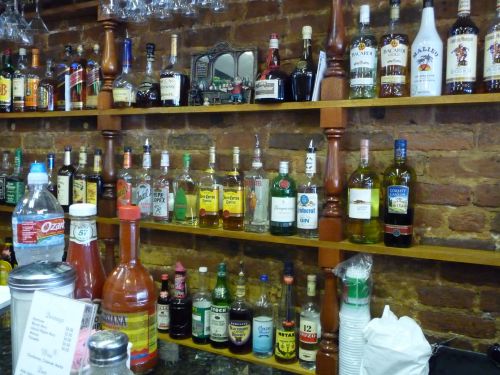Once you leave Mexico, drinking tequila is a dodgy issue. Take a look at the bar at Mena's Palace, a beloved luncheonette in the French Quarter of New Orleans. On the middle shelf you can find a couple of brands of tequila, "Juarez" and "Pepe Lopez," that I have never seen in Mexico. Call me skeptical, but I wouldn't disinfect my bathtub with that stuff. (I would also stay away from that bottle of "Aristocrat" gin.) Something tells me that Mena's has Greek owners, because on the bottom shelf they carry both Metaxa, a brandy I remember from my sojourn in Athens as a 20-year-old, and several brands of ouzo, including one that appears to be twelve years old.
Mexico City
Theatre
Two or three years ago, a friend named Daniel Pastor told me that he wanted to translate David Mamet's Oleanna and produce it onstage in Mexico City. Politely, I tried to discourage him, pointing out that the play had already been translated and produced here in the mid 1990s. I wondered out loud whether a twenty-year-old play that deals with sexual harassment would be understood in a country where sexual harassment is common, if not the norm.
Luckily, Daniel didn't give up. I went to the opening last Saturday and, to judge from the audience reaction, Oleanna is as relevant as ever -- perhaps more meaningful in Mexico today than it was fifteen years ago, as more people wake up to the concept of harassment.
It is a two-character play about a seemingly mousy and hapless university student who comes to a professor's office to implore him not to give her a failing grade. As John, the harried teacher, Juan Manuel Bernal's long-winded, pedantic speechifying is spot-on, but as Carol, his surprising pupil, Irene Azuela kicks ass. When the power shifts in the second and third scenes of the play, she is frightening in her intransigence and vengefulness.
Oleanna is on a Thursday through Sunday schedule at Teatro El Granero, behind the Auditorio Nacional in Chapultepec Park. Sadly, most of my friends in Mexico City never go to the theatre. Don't even think about missing this.
Party time
The New Orleans Saints go to the Super Bowl next Sunday. This is a first in the team's history, and for all we know, may be the last. But Mardi Gras comes every year, as attested by the Krewe de Vieux parade (one of the first of the season) a few nights ago. This particular parade is noted for political satire, this year directed at Mayor Ray Nagin, whose absence of leadership during and after Hurricane Katrina has been bitterly noted by nearly all citizens of the city. He will not be mayor much longer. Primary voting for the next election is scheduled for February 6, with a runoff, if necessary, set for early March. No one seems unhappy to see Nagin leave; indeed, he is cheerfully being referred to these days as "Na-gone."
The float in this photo depicts Nagin with the legend "Such a Blight." This is a play on words of a song title of one of New Orleans' own Dr. John's greatest hits, "Such a Night." Note the bottle in the tuba player's pocket.
This float shows Nagin in "City Hell" rather than City Hall. To judge by the beers in the revelers' hands, drinking is as much of a theme for the Krewe de Vieux as arch political commentary.
Some of the marchers had less subtle scorn to heap on Nagin (as well as Mitch Landrieu, his likely successor).
A couple of cool kitties.
Mexican Jewish history
Yes, there are Jews in Mexico. Supposedly, the first arrived among the Spanish conquerors, men who sailed with Cortés to escape the Inquisition. Today, in Mexico City there are fewer than forty thousand, which makes them a tiny minority in a city of twenty million people (ninety percent of whom declare themselves Catholic).
They are often the object of fascination of Catholic Mexicans. They arrived in greatest numbers in the first decades of the 20th century, principally immigrants from Central Europe, Lebanon, Greece and Syria. They tended to show up penniless, and began selling things on the streets of the centro histórico, soon graduating to shopkeepers and small-business proprietors. Today, most are professionals.
For over a dozen years, Monica Unikel-Fasja (pictured above) has given guided tours of the Jewish history of the centro. She points out, enters, and tells the stories of the buildings that housed the synagogues, jewelry, clothing and textile stores, community centers and gymnasiums of Mexico's early 20th-century Jewish communities.
You can find out more about Monica's tours by visiting her website (www.jewishtours.com.mx) or by emailing her directly at guidtour@prodigy.net.mx.
Who says gringos don't like soccer?
While looking for things for my apartment in New Orleans, I saw this charming conjunto for $199.99 at Royal Furniture at 2440 St. Claude Avenue. Could this be a testament to the growing popularity of soccer in the U.S.? Most of Royal's clients are black, but I wondered if this wasn't a special order for some of the tens of thousands of Mexicans who immigrated to New Orleans after Hurricane Katrina. They were largely responsible for the cleanup and reconstruction of the city.







